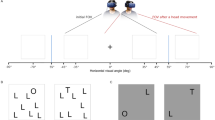Abstract
Under natural viewing conditions, humans are not aware of continually performing small head and eye movements in the periods in between voluntary relocations of gaze. It has been recently shown that these fixational head movements provide useful depth information in the form of parallax. Here, we replicate this coordinated head and eye movements in a humanoid robot and describe a method for extracting the resulting depth information. Proprioceptive signals are interpreted by means of a kinematic model of the robot to compute the velocity of the camera. The resulting signal is then optimally integrated with the optic flow to estimate depth in the scene. We present the results of simulations which validate the proposed approach.
Access this chapter
Tax calculation will be finalised at checkout
Purchases are for personal use only
Preview
Unable to display preview. Download preview PDF.
Similar content being viewed by others
References
Aloimonos, Y., Duric, Z.: Estimating the heading direction using normal flow. International Journal of Computer Vision 13(1), 33–56 (1994)
Ayache, N.: Artificial vision for mobile robots - stereo vision and multisensory perception. MIT Press (1991)
Aytekin, M., Rucci, M.: Motion parallax from microscopic head movements during visual fixation. Vision Research (August 2012)
Barron, J.L., Fleet, D.J., Beauchemin, S.S.: Performance of optical flow techniques. International Journal of Computer Vision 12(1), 43–77 (1994)
Davison, A.J., Reid, I.D., Molton, N.D., Stasse, O.: Monoslam: Real-time single camera slam. IEEE Transactions on Pattern Analysis and Machine Intelligence 29(6), 1052–1067 (2007)
Diankov, R., Kuffner, J.: Openrave: A planning architecture for autonomous robotics. Robotics Institute, Pittsburgh, PA, Tech. Rep. CMU-RI-TR-08-34 (2008)
Faugeras, O.D., Luong, Q.T., Papadopoulo, T.: The geometry of multiple images - the laws that govern the formation of multiple images of a scene and some of their applications. MIT Press (2001)
Higgins, L.H.C., Prazdny, K.: The Interpretation of a Moving Retinal Image. Proceedings of the Royal Society of London. Series B, Biological Sciences (1934-1990) 208(1173), 385–397 (1980)
Kuang, X., Gibson, M., Shi, B.E., Rucci, M.: Active vision during coordinated head/eye movements in a humanoid robot. IEEE Transactions on Robotics PP(99), 1–8 (2012)
Matthies, L., Kanade, T., Szeliski, R.: Kalman filter-based algorithms for estimating depth from image sequences. International Journal of Computer Vision 3(3), 209–238 (1989)
Ramachandran, M., Veeraraghavan, A., Chellappa, R.: A fast bilinear structure from motion algorithm using a video sequence and inertial sensors. IEEE Trans. Pattern Anal. Mach. Intell. 33(1), 186–193 (2011)
Rogers, B., Graham, M.: Motion parallax as an independent cue for depth perception. Perception 8(2), 125–134 (1979)
Sandini, G., Tistarelli, M.: Active tracking strategy for monocular depth inference over multiple frames. IEEE Transactions on Pattern Analysis and Machine Intelligence 12(1), 13–27 (1990), doi:10.1109/34.41380
Santini, F., Rucci, M.: Active estimation of distance in a robotic system that replicates human eye movement. Robotics and Autonomous Systems 55(2), 107–121 (2007)
Simoncelli, E., Adelson, E., Heeger, D.: Probability distributions of optical flow. In: Proceedings of the IEEE Computer Society Conference on Computer Vision and Pattern Recognition, CVPR 1991, pp. 310–315. IEEE (1991)
Author information
Authors and Affiliations
Editor information
Editors and Affiliations
Rights and permissions
Copyright information
© 2013 Springer-Verlag Berlin Heidelberg
About this paper
Cite this paper
Antonelli, M., del Pobil, A.P., Rucci, M. (2013). Depth Estimation during Fixational Head Movements in a Humanoid Robot. In: Chen, M., Leibe, B., Neumann, B. (eds) Computer Vision Systems. ICVS 2013. Lecture Notes in Computer Science, vol 7963. Springer, Berlin, Heidelberg. https://doi.org/10.1007/978-3-642-39402-7_27
Download citation
DOI: https://doi.org/10.1007/978-3-642-39402-7_27
Publisher Name: Springer, Berlin, Heidelberg
Print ISBN: 978-3-642-39401-0
Online ISBN: 978-3-642-39402-7
eBook Packages: Computer ScienceComputer Science (R0)




